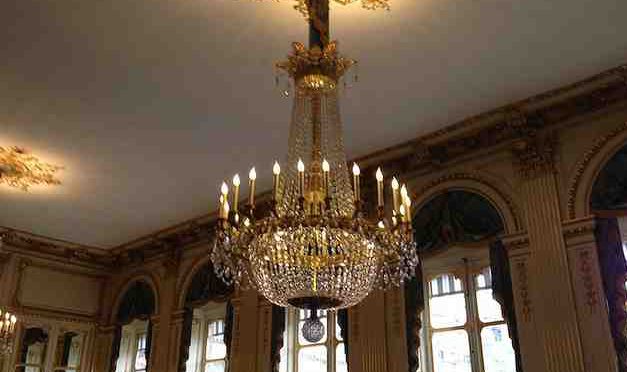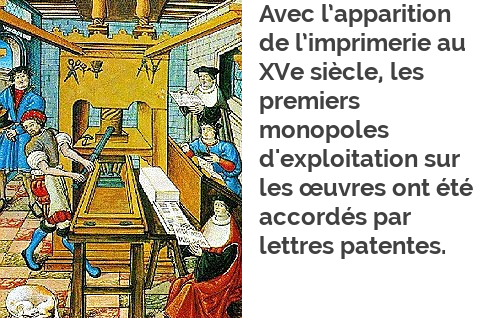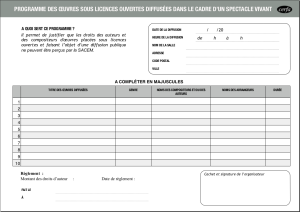Bonjour !
Une des licence proposée (ou plutôt ayant été proposée) sur Dogmazic ! C’est une licence initialement de 2004 dont le texte légal peut être sauvegardé ici. J’ai nommé, la licence: Developing Nations 2.0
Comme écrit plus haut, la licence Developing Nations 2.0 a été proposée sur Dogmazic, mais désormais elle est déconseillée par Creative Commons – qui recommande de ne pas l’appliquer aux oeuvres. Or je vous propose ici quelques traductions en français, d’articles postés en 2004 et 2007 sur le blog de Creative Commons, pour comprendre les idées véhiculées par cette licence.
Source: https://creativecommons.org/2004/09/13/developingnationslicenselaunched/
Traduction par Ladee.
Pourquoi alors, a-t-elle été retirée ?
Immédiatement la suite de votre feuilleton de licences:
La raison pratique est un simple manque d’intérêt: depuis le début, Creative Commons a promis de garder notre famille de licences aussi simple que possible. La demande actuelle a été un des indicateurs clés, montrant combien les choses peuvent être simples. Nous estimons à seulement 0.01% de nos licences les oeuvres sous Developing Nations, et 0.01% sous la version de la licence Sampling que nous retirons. Ces nombres parlent d’eux-même: il n’y a pas de demande pour ces licences.
Les raisons de principes sont différentes pour chaque licence. La licence Developing Nations est en conflit avec le mouvement en plein essor « Open Access Publishing » (NDLT: publications en accès libre). Car bien que les licences libérent le travail créatif dans ls pays en voie de développement, elles ne le libèrent pas, d’aucune façon, ailleurs. Cela signifie que ces licences ne remplissement pas les standards minimum du mouvement Open Access. Parce que ce mouvement est si important pour la propagation de la science et du savoir, nous ne pensons désormais plus comme correct de promouvoir une pareille version autonome de cette licence. Plus tard ce mois-ci, nous débuterons une discussion à propos de l’ajout des termes de la licence Developing Nations à 5 des autres licences CC. (Donc par exemple vous pourriez choisir une licence BY-NC pour les pays développés, mais offrir une licence BY pour les créateurs dans les Pays en voie de développement.) Parce qu’une telle option serait en lien avec une licence CC standard, elle ne serait plus en conflit avec les principes que nous avons énoncés ici.
En fonction des retours que nous aurons à propos de cette idée, nous déciderons de l’implémenter ou non. […]
Source: https://creativecommons.org/2007/06/04/retiring-standalone-devnations-and-one-sampling-license/
Traduction par Ladee.

Developing Nations 2.0
License
THE WORK (AS DEFINED BELOW) IS PROVIDED UNDER THE TERMS OF THIS CREATIVE COMMONS PUBLIC LICENSE (« CCPL » OR « LICENSE »). THE WORK IS PROTECTED BY COPYRIGHT AND/OR OTHER APPLICABLE LAW. ANY USE OF THE WORK OTHER THAN AS AUTHORIZED UNDER THIS LICENSE OR COPYRIGHT LAW IS PROHIBITED.
BY EXERCISING ANY RIGHTS TO THE WORK PROVIDED HERE, YOU ACCEPT AND AGREE TO BE BOUND BY THE TERMS OF THIS LICENSE. THE LICENSOR GRANTS YOU THE RIGHTS CONTAINED HERE IN CONSIDERATION OF YOUR ACCEPTANCE OF SUCH TERMS AND CONDITIONS.
1. Definitions
- « Collective Work » means a work, such as a periodical issue, anthology or encyclopedia, in which the Work in its entirety in unmodified form, along with a number of other contributions, constituting separate and independent works in themselves, are assembled into a collective whole. A work that constitutes a Collective Work will not be considered a Derivative Work (as defined below) for the purposes of this License.
- « Derivative Work » means a work based upon the Work or upon the Work and other pre-existing works, such as a translation, musical arrangement, dramatization, fictionalization, motion picture version, sound recording, art reproduction, abridgment, condensation, or any other form in which the Work may be recast, transformed, or adapted, except that a work that constitutes a Collective Work will not be considered a Derivative Work for the purpose of this License. For the avoidance of doubt, where the Work is a musical composition or sound recording, the synchronization of the Work in timed-relation with a moving image (« synching ») will be considered a Derivative Work for the purpose of this License.
- « Developing Nation » means any nation that is not classified as a « high-income enconomy » by the World Bank.
- « Licensor » means the individual or entity that offers the Work under the terms of this License.
- « Original Author » means the individual or entity who created the Work.
- « Work » means the copyrightable work of authorship offered under the terms of this License.
- « You » means an individual or entity exercising rights under this License who has not previously violated the terms of this License with respect to the Work, or who has received express permission from the Licensor to exercise rights under this License despite a previous violation.
2. Fair Use Rights. Nothing in this license is intended to reduce, limit, or restrict any rights arising from fair use, first sale or other limitations on the exclusive rights of the copyright owner under copyright law or other applicable laws.
3. License Grant. Subject to the terms and conditions of this License, Licensor hereby grants You a worldwide, royalty-free, non-exclusive, perpetual (for the duration of the applicable copyright or subject to Section 7(a)) license to exercise the rights in the Work, in any Developing Nation, solely within the geographic territory of one or more Developing Nations, as stated below:
- to reproduce the Work, to incorporate the Work into one or more Collective Works, and to reproduce the Work as incorporated in the Collective Works;
- to create and reproduce Derivative Works;
- to distribute copies or phonorecords of, display publicly, perform publicly, and perform publicly by means of a digital audio transmission the Work including as incorporated in Collective Works;
- to distribute copies or phonorecords of, display publicly, perform publicly, and perform publicly by means of a digital audio transmission Derivative Works;
- For the avoidance of doubt, where the work is a musical composition:
- Performance Royalties Under Blanket Licenses. Licensor waives the exclusive right to collect, whether individually or via a performance rights society, royalties for the public performance or public digital performance (e.g. webcast) of the Work.
- Mechanical Rights and Statutory Royalties. Licensor waives the exclusive right to collect, whether individually or via a music rights agency or designated agent, royalties for any phonorecord You create from the Work (« cover version ») and distribute, subject to any compulsory license that may apply.
- Webcasting Rights and Statutory Royalties. For the avoidance of doubt, where the Work is a sound recording, Licensor waives the exclusive right to collect, whether individually or via a performance-rights society, royalties for the public digital performance (e.g. webcast) of the Work, subject to any compulsory license that may apply.
The above rights may be exercised in all media and formats whether now known or hereafter devised. The above rights include the right to make such modifications as are technically necessary to exercise the rights in other media and formats. All rights not expressly granted by Licensor are hereby reserved, including but not limited to the rights and restrictions described in Section 4.
4. Restrictions. The license granted in Section 3 above is expressly made subject to and limited by the following restrictions:
- You may distribute, publicly display, publicly perform, or publicly digitally perform the Work only under the terms of this License, and You must include a copy of, or the Uniform Resource Identifier for, this License with every copy or phonorecord of the Work You distribute, publicly display, publicly perform, or publicly digitally perform. You may not offer or impose any terms on the Work that alter or restrict the terms of this License or the recipients’ exercise of the rights granted hereunder. You may not sublicense the Work. You must keep intact all notices that refer to this License and to the disclaimer of warranties. You may not distribute, publicly display, publicly perform, or publicly digitally perform the Work with any technological measures that control access or use of the Work in a manner inconsistent with the terms of this License Agreement. The above applies to the Work as incorporated in a Collective Work, but this does not require the Collective Work apart from the Work itself to be made subject to the terms of this License. If You create a Collective Work, upon notice from any Licensor You must, to the extent practicable, remove from the Collective Work any reference to such Licensor or the Original Author, as requested. If You create a Derivative Work, upon notice from any Licensor You must, to the extent practicable, remove from the Derivative Work any reference to such Licensor or the Original Author, as requested.
- If you distribute, publicly display, publicly perform, or publicly digitally perform the Work or any Derivative Works or Collective Works, You must keep intact all copyright notices for the Work and give the Original Author credit reasonable to the medium or means You are utilizing by conveying the name (or pseudonym if applicable) of the Original Author if supplied; the title of the Work if supplied; to the extent reasonably practicable, the Uniform Resource Identifier, if any, that Licensor specifies to be associated with the Work, unless such URI does not refer to the copyright notice or licensing information for the Work; and, in the case of a Derivative Work, a credit identifying the use of the Work in the Derivative Work (e.g., « French translation of the Work by Original Author, » or « Screenplay based on original Work by Original Author »). Such credit may be implemented in any reasonable manner; provided, however, that in the case of a Derivative Work or Collective Work, at a minimum such credit will appear where any other comparable authorship credit appears and in a manner at least as prominent as such other comparable authorship credit.
- The Work and any Derivative Works and Collective Works may only be exported to other Developing Nations, but may not be exported to countries classified as « high income » by the World Bank.
- This License does not authorize making the Work, any Derivative Works or any Collective Works publicly available on the Internet unless reasonable measures are undertaken to verify that the recipient is located in a Developing Nation, such as by requiring recipients to provide name and postal mailing address, or by limiting the distribution of the Work to Internet IP addresses within a Developing Nation.
5. Representations, Warranties and Disclaimer
UNLESS OTHERWISE MUTUALLY AGREED TO BY THE PARTIES IN WRITING, LICENSOR OFFERS THE WORK AS-IS AND MAKES NO REPRESENTATIONS OR WARRANTIES OF ANY KIND CONCERNING THE WORK, EXPRESS, IMPLIED, STATUTORY OR OTHERWISE, INCLUDING, WITHOUT LIMITATION, WARRANTIES OF TITLE, MERCHANTIBILITY, FITNESS FOR A PARTICULAR PURPOSE, NONINFRINGEMENT, OR THE ABSENCE OF LATENT OR OTHER DEFECTS, ACCURACY, OR THE PRESENCE OF ABSENCE OF ERRORS, WHETHER OR NOT DISCOVERABLE. SOME JURISDICTIONS DO NOT ALLOW THE EXCLUSION OF IMPLIED WARRANTIES, SO SUCH EXCLUSION MAY NOT APPLY TO YOU.
6. Limitation on Liability. EXCEPT TO THE EXTENT REQUIRED BY APPLICABLE LAW, IN NO EVENT WILL LICENSOR BE LIABLE TO YOU ON ANY LEGAL THEORY FOR ANY SPECIAL, INCIDENTAL, CONSEQUENTIAL, PUNITIVE OR EXEMPLARY DAMAGES ARISING OUT OF THIS LICENSE OR THE USE OF THE WORK, EVEN IF LICENSOR HAS BEEN ADVISED OF THE POSSIBILITY OF SUCH DAMAGES.
7. Termination
- This License and the rights granted hereunder will terminate automatically upon (i) any breach by You of the terms of this License or (ii) if any Developing Nation in which the Work is used, exported or distributed ceases at any time to qualify as a Developing Nation, in which case this License will automatically terminate with respect to such country five (5) years after the date of such re-classification; provided that You will not be liable for copyright infringement unless and until You continue to exercise such rights after You have actual knowledge of the termination of this License for such country. Individuals or entities who have received Derivative Works or Collective Works from You under this License, however, will not have their licenses terminated provided such individuals or entities remain in full compliance with those licenses. Sections 1, 2, 5, 6, 7, and 8 will survive any termination of this License.
- Subject to the above terms and conditions, the license granted here is perpetual (for the duration of the applicable copyright in the Work). Notwithstanding the above, Licensor reserves the right to release the Work under different license terms or to stop distributing the Work at any time; provided, however that any such election will not serve to withdraw this License (or any other license that has been, or is required to be, granted under the terms of this License), and this License will continue in full force and effect unless terminated as stated above.
8. Miscellaneous
- Each time You distribute or publicly digitally perform the Work or a Collective Work, the Licensor offers to the recipient a license to the Work on the same terms and conditions as the license granted to You under this License.
- Each time You distribute or publicly digitally perform a Derivative Work, Licensor offers to the recipient a license to the original Work on the same terms and conditions as the license granted to You under this License.
- If any provision of this License is invalid or unenforceable under applicable law, it shall not affect the validity or enforceability of the remainder of the terms of this License, and without further action by the parties to this agreement, such provision shall be reformed to the minimum extent necessary to make such provision valid and enforceable.
- No term or provision of this License shall be deemed waived and no breach consented to unless such waiver or consent shall be in writing and signed by the party to be charged with such waiver or consent.
- This License constitutes the entire agreement between the parties with respect to the Work licensed here. There are no understandings, agreements or representations with respect to the Work not specified here. Licensor shall not be bound by any additional provisions that may appear in any communication from You. This License may not be modified without the mutual written agreement of the Licensor and You.
Source: https://creativecommons.org/licenses/devnations/2.0/legalcode



